Here’s a Look at Some Affordable Aviation Favorites
The light sport aircraft market sits poised for growth in the dawn of MOSAIC.

The two-seat Texas Aircraft Colt makes for a fine trainer—and it won a FLYING Editors’ Choice Award in 2020. [Courtesy: Texas Aircraft]
Employing aviation effectively can bring people together and transport goods quickly, integrating societies around the globe. These are noble and worthy pursuits.
Yet as demonstrated by broad participation in art, music, or sport, individuals seek more than practical solutions. Sometimes the activities that inspire us most are those which free our minds and lift our spirits.
The aircraft in this portion of FLYING’s Buyers Guide this year might be called “joy machines,” for their mission is to elevate you—physically and emotionally.
If you're not already a subscriber, what are you waiting for? Subscribe today to get the issue as soon as it is released in either Print or Digital formats.
Subscribe NowWelcome to recreational—and, yes, affordable—aviation. To offer a taste of the 158 aircraft the FAA has accepted as special (fully built) light sport aircraft (LSA)—plus more than 100 kit-built models—I’ve divided the subject aircraft into several categories, with three outlined here. These aircraft are good representatives but between them account for just a small percentage of the models available.
Buyers enjoy many diverse choices, one of which might be perfect for them. I encourage you to explore the segment more fully at ByDanJohnson.com (to become AffordableAviation.com), now a member of the FLYING family.
Our Favorite LSA
Light sport aircraft have been part of the aviation firmament for almost 20 years, and over that time, some models established themselves even as newcomers regularly arrive. The way the FAA accepts (not “certifies”) these airplanes allows rapid improvement, which has stimulated surprisingly fast progress. What will happen as the Modernization of Special Airworthiness Certification’s (MOSAIC) recent rulemaking comes to conclusion looks like it will only serve to expand upon the grand variety and capability we witness on the market—such as expanding the envelope of the Bristell SLSA featured in our opening spread, and in the April 2023/Issue 936 edition of FLYING.
- READ MORE: We Fly: BRM Aero Bristell SLSA
The Evektor Harmony is a next-generation model following its SportStar, which will forever hold the title of the first special LSA accepted by the FAA in April 2005 only weeks after the new sport pilot/light sport aircraft regulation was released. Flight Design’s CT was accepted the same day.
Being first often conveys some advantage, but in an industry where new ideas often emerge, a successful producer cannot long rest on past achievements. Based in an aviation-rich area of the Czech Republic, Evektor steadily upgraded its SportStar through a series of alterations. Later, the company introduced the Harmony with added sophistication.
The Harmony uses a more advanced compound wing—the leading edge does not form a straight line—to bring performance up to the top of the category (restricted by present regulation, which may change with MOSAIC). Pilots who fly the Harmony say it feels like a legacy GA airplane.
The Jabiru J-230D, hailing from Australia, is the result of years of development, beginning long before light sport aircraft came along. When FAA’s rule hit in 2004, the Down Under designer and manufacturer was quick to adapt its kit products to the new market.
The J-230D resembles the company’s J-400, a four-seater. That many seats aren’t permitted on LSA, so out they came, leaving an aft interior bigger than a Cessna 150. A third door sized for people brings the easiest luggage area loading among LSA—you can easily take your pet along. Jabiru is a rare airframe manufacturer that also makes its own engine. When you hear the word “Jabiru” (a large bird), you need to think airplane and powerplant, though the engines are also used on other airframes. A J-230D with the 6-cylinder Jabiru 3300 can readily hit the top speed among LSA.
The 2020 FLYING Editors’ Choice Award-winning Texas Aircraft Colt relies on the great success of a predecessor Brazilian design, but the Colt is all American. One of the newer aircraft to the LSA fleet in the U.S., developers had the advantage of seeing what pilots were buying…and what they were requesting.
With its conventional yoke control, the Colt breaks a familiar mold in LSA, an overwhelming majority of which use joysticks in various forms. A refined aircraft, the Colt is beautifully appointed inside and out, attracting pilots seeking a legacy GA airplane look in a ground-up-new design that can be operated by a sport or higher-certificated pilot exercising the no-medical privileges of LSA.
Built in Hondo, Texas, with local support, the Colt joins the best of an experienced Brazilian aircraft designer with American airplane-building capability in the U.S.
Seaplane LSAs
Seaplanes quickly earn a special place in some aviators’ hearts because of their unique ability to land on water and for the versatility that amphibious gear affords. The FAA recognized this interest and allowed 110 pounds more gross weight for qualifying seaplanes and also permitted amphibious gear. With a water-going craft, you have vastly more places to make a landing, whether for a pleasant visit or an emergency.
From its first announcement, pilots could see ICON’s A5 LSA seaplane was something distinctive. Its hull and fuselage blended form and function to retract gear invisibly while providing stability on the water. When its wings were electrically folded, jaws dropped; many envisioned how to launch A5 at their local marina.
The California developer went on to a long development period where every detail was sussed out to an intricate degree. The resultant aircraft that emerged addressed FAA’s current counsel to industry: “Make these aircraft easy to fly, operate, and maintain.” Three checks for ICON engineers and company leadership. They forged ahead while maintaining the smooth lines of early prototypes.
By 2022, ICON rose to be one of the leading suppliers in the LSA industry, and those of us lucky enough to have operated its well-located controls quickly acquired large smiles. A5 is simple and responsive, stall resistant, and stable. The modern sports car cabin is comfortable and spacious. Amphibious gear makes the A5 versatile and puts America’s many waterways on the list of available landing areas.
Vickers Aircraft closely observed ICON after it made a big splash with the A5. Vickers, based in New Zealand, saw an opportunity to achieve even more with its Wave. And engineers took a different approach to creating it. Using modern CAD methods and software similar to Boeing or Lockheed Martin, Vickers worked for years before unveiling a product but, when it did, it flew “right out of the box.” The company remains in testing as it works toward FAA acceptance but believes it can swiftly move to manufacturing because of the detailed preparation work. Indeed, elements are already being produced. The Wave first tempted buyers with prices substantially below ICON’s eye-watering $394,000, although continued improvements and the latest engine from Rotax have pushed up its costs. All told, the Wave is an intriguing amphibian loaded with features and boasting a large interior complete with sliding doors.
Scoda Aeronautica’s Super Petrel started its life in France. It was much different before the team at Edra, now Scoda Aeronautica, took over in Brazil. Here’s another seaplane entry from the South American nation that is very big in aviation. The Super Petrel sets itself apart from all others with its biwing construction. You may not think that’s logical in the modern world, but the Super Petrel is a highly efficient aircraft. Plenty of wing area helps it leave the water faster. The shorter the water run, the less strain on an airframe. LSA seaplanes are masterful at this task, jumping off the water in a few seconds. The higher power-to-weight ratio helps, but Scoda wanted to go even further.
Scoda’s XP designation for the Super Petrel means extra performance, but you also get more airplane. The airframe was extended by 10 inches, bringing with it a bounty of benefits, including more luggage area. With Rotax’s 141 hp 915iS engine atop the center of gravity, Super Petrel leaps out of the water with great energy.
Niche Buys
The Airplane Factory’s Sling HW, or High Wing, is an all-new design clearly aimed at FAA’s coming MOSAIC regulation. A quick glance at the specifications below illustrates that Sling HW is well outside the current regulation for light sport aircraft. That’s OK for now. It can start with a kit or import a few aircraft in the experimental/exhibition category.
Numbers are bigger than for a present-day LSA, and that’s great if you seek extra capability. Be prepared to pay for it. Most MOSAIC-targeted LSA unveiled to date are often well into the $200,000s. Several exceed $300,000. Still, that’s much less than a comparable legacy GA aircraft, and Sling HW is big, comfortable, and well equipped. A sleek composite exterior helps it outperform comparable models.
These MOSAIC light sport aircraft (MLSA) are going to greatly expand the LSA range, and Sling producer TAF has long been an innovator.
It is also supremely confident in its designs and loves to demonstrate that by literally flying a new design all the way around the world. In fact, it has done so several times.



Kit-Built
Building your own aircraft involves much more than just saving money—just ask the experts at Van’s Aircraft, who offer both SLSA and kit versions of the RV-12. For most, it is a learning experience, a use of craftsmanship, or simply an absorbing hobby. When you’re done, you will know it in a way few pilots know their aircraft. You can also put in it precisely what you want.
Lockwood Aircraft’s AirCam is no light sport aircraft, but it might qualify as a MLSA. The AirCam has been such a hit that 200 have been built as kits. It looks somewhat unorthodox with its twin aft-mounted Rotax engines on a half-open-cockpit design, but you need to know why it looks this way.
The AirCam was custom designed and built for one job—taking National Geographic-grade cover story photos of Namibian jungles and African wildlife. The country’s terrain is utterly unforgiving. Clearings are few and small. The photographer, seated up front for photo missions, needs huge visibility and no obstructions. Plus, they wish to fly at the speed of nature, that is, slowly. The AirCam accomplishes all this like it was designed for it—because it was.
This story first appeared in the September 2023/Issue 941 of FLYING’s print edition.

Subscribe to Our Newsletter
Get the latest FLYING stories delivered directly to your inbox







